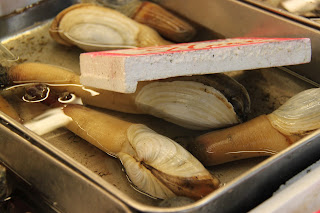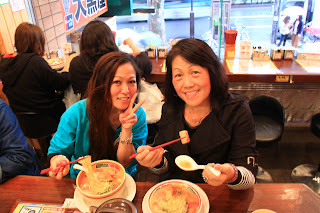A trip to Tokyo would never complete without a visit to the world's largest fish market, Tsukiji Market, which is located in the heart of Tokyo city. It is a must go culinary destination especially for sashimi lovers. People coming here to trade in more than 2,000 varieties of the freshest catch from a port nearby, with many restaurants and retail shops lined around the market.
The shops start their operation at around 5a.m. or 6a.m., before you can see the first sun ray, with its very much talked about tuna auction taking place at the inner market, which generally starts at around 5 a.m. There is a fixed number of 120 visitors who are allowed to go in for the auction in a day. The registration for the tuna auction at the 'Fish Information Counter' will be closed once the number hits the limit. So make sure you have to be very early to register, as it's on first come first served basis.
We took Oedo Subway line, got off at Tsukiji-Shijo station, and looked for exit A1, walked up a staircase where we were greeted by fishy smell before we could even see the market. You will see people with plastic bags in hand, just finished doing their marketing chores. I could not bring myself out from the bed in time for the tuna auction in the wee morning hour, hence my mum and me were all set for some sashimi breakfast in one of the sushi restaurants with the longest Q, Daiwa Zushi. I did my research and went through some reviews about very much loved Daiwa Zushi, boasted that one must at least stand in Q for more than an hour to get a seat in their restaurant. It was indeed very true. But what the heck, I had to satisfy my culinaray tastebuds, which was my main mission to drop by!
Tsukiji Market is divided into outer and inner markets. Outer market is opened to public whereas the inner market is restricted to wholesalers.
The workers were seen busy in their daily activities of unloading their goods.
However, be careful everytime you wandering around the market. There are so many delivery trucks and carts, often driven by cigarette-smoking workers, zooming pass, weaving in and out along the narrow streets.
In the retail shops at the outer market, you can see all sort of things from knives, ceramic utensils and kitchenware, vegetables, pickles, dried seafoods, teas, and many sushi and sashimi restaurants which obtain their seafood supply straight from the fish market nearby.
I bought some seaweed, kombu, and green tea from this small little shop. A picture with its friendly staffs.
Busy daily activities in Tsukiji.
Though it was only 8 plus in the morning, beelines were seen outside the famous sushi restaurants, like Daiwa Sushi and Sushi Dai. Both of them are located in the same row of shops with Sushi Dai at the first and Daiwa Sushi at the 4th after Sushi Dai.
I chose Daiwa Sushi and waited patiently for an hour or so, before guided into the restaurant by an obasan.
Some also commented the other restaurants serve equally good and fresh sashimi, as they also get their supply from Tsukiji. So there would be no fuss Q-ing in line to have your sashimi craving satisfied.
An uncle unloading his seafood goods from the cart into Daiwa Sushi.
While waiting in line, I sneakily took a peek through the glass and snapped a picture of sushi chefs at work. A chef saw my big ass DSLR, and posed with a peace sign. (Japanese love to take pictures with hand signature peace sign)
After left seated at the sushi counter, where we could see clearly sushi chefs skillfully sliced the sashimi and rolled the maki and handrolls. Mum and I opted for omakase, the chef's choice, which costs 3,500 yen ($55 plus) per person.
We were served with asari (clam) miso soup and a cup of fragrant hot green tea almost immediately.
The empty asari shells. They tasted so fresh, sweet and yummy. Love the soup.
The fattest buttery creamy otoro sushi. It melted in my mouth and oozed out its fattiness before gliding down through my throat. Oh...can I have more, plee..ase? Oh, if you don't know, please do not mix wasabi into the light soya sauce. Place a bit of wasabi onto the sashimi, and dip it into the soya sauce on the raw fish not on the sushi rice. This is to prevent the rice from getting too salty. However, the chef will advise you whether to eat the sashimi or sushi with or without any sauce in order to retain its original flavour and goodness.
And the wasabi is grated from the fresh wasabi root, not the processed ready-to-use paste from a tube, which is normally too overpowering. And eat the gari (pickled sliced ginger) to help in cleansing the palate between different types of sushi.
Some tuna and fish roe maki sushi.
I could not help but to order a fresh scallop served as sashimi after peeping into the glass counter in front of me. I could almost taste ocean and the scallop meat was so sweet and incredibly yummy. At the end of the meal, we were stuffed! I wished I could stuff more sashimi into my belly, after all the long wait!
The chef who served us was so friendly, that he never hesitate to pose for a picture albeit many patrons were still Q-ing outside the restaurant. He even joked with us, and tried his very best to amuse us with his little mandarin-spoken conversation.
After a satisfying meal, we strolled around the market.
Vegetable stalls selling wild sansai (mountain vegetables). Below is kogomi, a kind of fern.
Wasabi root.
Fish stalls selling all kinds of seafood and I reckoned some which I never see in my life. Below is my favourite creamy shirako (fish sperm sac) which is normally available in winter.
Raw eyeballs, anyone?
The bloody cockles, which is as big as a palm.
So fresh that it's gasping for air.
Fresh moving abalone.
Fresh geoduck clams.
Fresh scallop
Hairy gigantic crab
Worker sawing frozen tuna into pieces with a bandsaw.
Halved frozen tuna.
A smiley friendly worker in the market.
Mentaiko (marinated fish roe)
This young Japanese chap caught my attention, coz he was a fishmonger with a 'gangster' look, and yet he had a neat and trimmed eyebrows. Talking about personal grooming is always a Japanese's forte.
Mantis prawns
Fresh tuna (unfrozen)
Do you notice there's a group of tourists were up to something? I dare not to move nearer....find out why...
They were actually waiting anxiously for this old man to slice open a fresh whole tuna, while he sharpened his sword-looking knife. He tried to shoo these irritating tourists away but to no avail.
Good quality knives are very important for Japanese, as eating raw fish requires them to slice and debone alive fish with high skill and knowledge.
Workers started to clean their work stations and ready to call it a day, by 11 a.m.
Thereafter, we walked further around the vicinity and found a small temple.
Many shops with local people, getting their daily necessities. This shop selling all kinds of grains and dried goods.
It's best to come to Tsukiji Market with empty stomach, because you are not only awed by varieties of fresh seafood, there are so many food stalls. Walk and munch all the way as you like. Trust me, you would never go hungry.
Below is savoury, fluffy thick omelette (tamagoyaki). Some are plain, some are stuffed with fillings like grilled eel, herbs, or shrimp. There are at least 2 famous tamagoyaki shops here. Just get yours from a stall with many people Q-ing, that's normally the case, right?
Or if you are a sweet-tooth person, get yourself some wagashi (Japanese confections). Japanese normally have an affinity for seasonal motifs, which their wagashi are artfully presented. During my visit in Spring, they were mostly pastel-colored flowers of plum and sakura.
Dorayaki (a small-pancake-like cakes) stuffed with azuki (red bean) paste. The snack which is fancied by Doraemon :D
Dried seafood
Next, we went to the Imperial Palace where their Majesties, the Emperor and Empress reside, which is situated in the center of Tokyo. To get there, we travelled on Tozai Subway line, got off at Takebashi Station, and took the Otemachi Gate Exit 2. Below is a train section dedicated only for women commuters on weekdays from 6.57 a.m. to 9 a.m., during morning rush hours.
Once we stepped out from the Takebashi station, we saw rows of sakura trees, leading to the Imperial Palace during spring season.
At the Imperial Palace East Garden (Kokyo Higashi Gyoen). Avoid Monday and Friday when East Garden is closed for visiting.
These cute obasans offered in helping me taking a picture with sakura tree, so I initiated to take a picture of them.
A kind of Iris plant which normally blooms in May to July.
We walked a bit further towards Tokyo Station, where we saw the Imperial Palace Outer Garden (Kokyo Gyoen) . We did not step into the garden, just took pictures of the palace, surrounded by a water-filled moat and tree-covered grounds - a precious sight of nature within the bustling metropolitan city.
To end the day, we spend the evening at Harajuku again. This time, we walked along Omotesando which is full of cafes and international brand clothing boutiques along with the upmarket Omotesando Hills shopping complex. Omotesando is contrastly different from cheaper bargain found at Takeshita Dori, which is only a short walk away.
A shot from an overhead bridge looking down at Omotesando.
Across the bridge, Kiddy land is a must go place to get souvenirs and toys for the little ones. Even an adult like me would be fascinated with so many cutie plush toys, handphone accessories, kitchenware, stationeries, toys and a lot more which are so hard to resist!
The ground floor, stuffed with Rilakkuma
The 3rd floor with my super loved Hello Kitty stuffs. I spent at least 3 hours rummaging the whole floors for my items and of course burnt a hole in the pocket of a few hundred dollars for the purchase!
Our dinner was at well-regarded Kyusyu Jangara, a ramen chain restaurant, offering exquisite tonkotsu (pork bone) soup and extra-thin noodles. You can choose combinations from several types of soup and toppings available. The soups include the basic and simple Jangara, and the fatty Bonshan, the median between the two extremes is Kobonshan, as well as the spicy Karabon. For extra toppings, you can opt for Kakuni (stewed pork block) and Chashu (pork tenderloin), and Aji Tamago (flavored boiled egg).
There are 6 outlets within Tokyo, with Harajuku branch is a quick walk from Harajuku Station.
This place is so packed, but the staff offered himself to take a picture for us. Japanese are so kind and friendly. That is why I never get sick of Japan!
The number 1 rated, Kyusyu Jangara...
The bill rounded up to 2100 yen for 2 people (S$33 plus)
These are the hauls from Kiddy land.
And some bling bling girly accessories for myself from Before the Bloom.













































































No comments:
Post a Comment